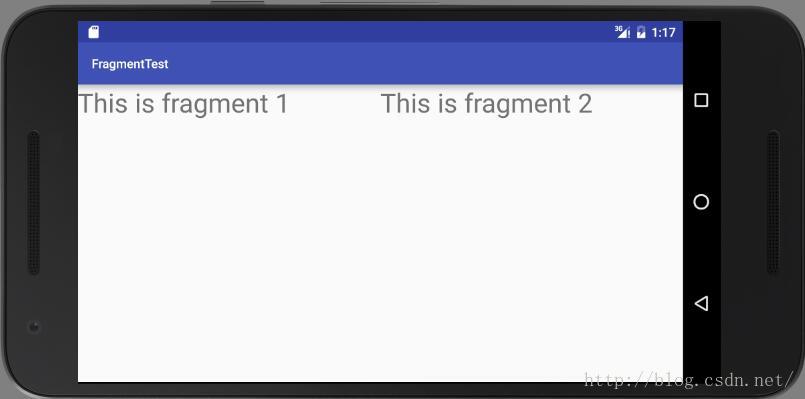Fragment
Posted 故意的是吧
tags:
篇首语:本文由小常识网(cha138.com)小编为大家整理,主要介绍了Fragment相关的知识,希望对你有一定的参考价值。
在android3.0中引入了Fragments的概念,主要目的是用在大屏幕设备上(如平板电脑),支持更多动态和灵活的UI设计。利用平板电脑的大屏幕,放入更多UI组件,组件之间会产生更多的交互。
Fragment在应用中应当是一个模块化和可重用的组件,因为Fragment定义了它自己的布局,以及通过使用它自己的生命周期回调方法定义了自己的行为,可以将Fragment包含到多个Activity中
知识概括:可以理解为Activity是一座房子,Fragment是其中一个房间样式
1、Fragment可以作为Activity界面的一部分组成出现
2、可以在一个Activity中同时出现多个Fragment,并且一个Fragment也可以在多个Activity中使用
3、在Activity运行过程中,可以添加、移除、替换Fragment
4、Fragment可以响应自己的输入事件,并且有自己的生命周期。他们的生命周期会受宿主Activity的生命周期影响。
onCreateView()方法
Fragment第一次绘制它的用户界面的时候,系统会调用此方法,为了绘制Fragment的UI,此方法必须返回一个View。如果不显示UI,则返回null即可。
加载方式:
1、静态加载
在Activity的layout文件中生命Fragment,需要注意<fragment>中的android:name属性指定了再layout中实例化的Fragment类。
标示Fragment的方法:
android:id 属性一共一个唯一的ID
android:tag属性提供了唯一的字符串
例1:
新建fragment1.xml
<?xml version="1.0" encoding="utf-8"?>
<LinearLayout xmlns:android="http://schemas.android.com/apk/res/android"
android:orientation="vertical" android:layout_width="match_parent"
android:layout_height="match_parent">
<TextView
android:layout_width="wrap_content"
android:layout_height="wrap_content"
android:text="This is fragment 1"
android:textSize="30sp"/>
</LinearLayout>
<?xml version="1.0" encoding="utf-8"?>
<LinearLayout xmlns:android="http://schemas.android.com/apk/res/android"
android:orientation="vertical" android:layout_width="match_parent"
android:layout_height="match_parent">
<TextView
android:layout_width="wrap_content"
android:layout_height="wrap_content"
android:text="This is fragment 2"
android:textSize="30sp"/>
</LinearLayout>
<?xml version="1.0" encoding="utf-8"?>
<LinearLayout xmlns:android="http://schemas.android.com/apk/res/android"
xmlns:tools="http://schemas.android.com/tools"
android:layout_width="match_parent"
android:layout_height="match_parent"
tools:context="com.bcp.fragmenttest.MainActivity">
<fragment
android:name="com.bcp.fragmenttest.Fragment1"
android:layout_width="0dp"
android:layout_weight="1"
android:layout_height="match_parent"
android:id="@+id/fragment1"/>
<fragment
android:name="com.bcp.fragmenttest.Fragment2"
android:layout_width="0dp"
android:layout_weight="1"
android:layout_height="match_parent"
android:id="@+id/fragment2"/>
</LinearLayout>
package com.bcp.fragmenttest;
import android.app.Fragment;
import android.os.Bundle;
import android.view.LayoutInflater;
import android.view.View;
import android.view.ViewGroup;
/**
* Created by super on 2016/4/26.
*/
public class Fragment1 extends Fragment
@Override
public View onCreateView(LayoutInflater inflater, ViewGroup container, Bundle savedInstanceState)
return inflater.inflate(R.layout.fragment1, container, false);
新建Fragment2.java
package com.bcp.fragmenttest;
import android.app.Fragment;
import android.os.Bundle;
import android.view.LayoutInflater;
import android.view.View;
import android.view.ViewGroup;
/**
* Created by super on 2016/4/26.
*/
public class Fragment2 extends Fragment
@Override
public View onCreateView(LayoutInflater inflater, ViewGroup container, Bundle savedInstanceState)
return inflater.inflate(R.layout.fragment2,container,false);
package com.bcp.fragmenttest;
import android.support.v7.app.AppCompatActivity;
import android.os.Bundle;
public class MainActivity extends AppCompatActivity
@Override
protected void onCreate(Bundle savedInstanceState)
super.onCreate(savedInstanceState);
setContentView(R.layout.activity_main);
运行效果:

2、动态加载
撰写代码将Fragment添加到一个Activity layout中,
add() 添加一个Fragment(指定要添加的Fragment和插入的View)
类似的还有remove()、替换()
处理Fragment事务:根据用户的情况,对Fragment进行添加、移除、替换,以及执行其他动作,提交给Activity的每一套变化被称为一个事务。
FragmentManager fragmentManager = getFragmentManager ();
FragmentTransaction beginTransaction = fragmetnManager.beginTransaction();
每一个事务都是同时执行的一套变化,可以在一个事务中设置你所有想执行的变化,包括add()、remove()、replace()。然后提交给Activity,必须调用commit()方法
如果允许用户通过按下BACK键返回到前一个Fragment状态,调用commit()之前可以加入addToBackStack()方法
动态加载Fragment主要分4步:
1、获取到FragmentManager,在Activity中可以直接通过getFragmentManager得到;
2、开启一个事务,通过调用beginTransaction方法开启;
3、向容器内加入Fragment,一般使用replace方法实现,需要传入容器的id和Fragment的实例;
4、提交事务,使用commit方法提交。
例2:
在例1基础上做修改,横屏显示fragment1、竖屏显示fragment2
activity_main.xml
<?xml version="1.0" encoding="utf-8"?>
<LinearLayout xmlns:android="http://schemas.android.com/apk/res/android"
xmlns:tools="http://schemas.android.com/tools"
android:layout_width="match_parent"
android:layout_height="match_parent"
tools:context="com.bcp.fragmenttest.MainActivity"
android:id="@+id/main_layout"
android:orientation="horizontal">
</LinearLayout>package com.bcp.fragmenttest;
import android.app.Activity;
import android.app.Fragment;
import android.support.v7.app.AppCompatActivity;
import android.os.Bundle;
import android.view.Display;
public class MainActivity extends Activity
@Override
protected void onCreate(Bundle savedInstanceState)
super.onCreate(savedInstanceState);
setContentView(R.layout.activity_main);
//获取屏幕宽度和高度
Display display=getWindowManager().getDefaultDisplay();
//宽度大于高度
if (display.getWidth()>display.getHeight())
//加载fragment1
Fragment1 fragment1=new Fragment1();
getFragmentManager().beginTransaction().replace(R.id.main_layout,fragment1).commit();
else
//高度大于宽度,加载fragment2
Fragment2 fragment2=new Fragment2();
getFragmentManager().beginTransaction().replace(R.id.main_layout,fragment2).commit();
生命周期:
重要方法 --
onAttach() Fragment和Activity建立关联的时候调用
onCreateView() 为Fragment加载布局时调用
onActivityCreate() 当Activity中的onCreate执行完后调用
onDestroyView() Fragment中的布局被移除时调用
onDetach() Fragment和Activity解除关联的时候调用
启动程序:
onAttach()---onCreate()---onCreateView()---onActivityCreated()---onStart()---onResume()
点击home键时:
onPause()---onStop()
再次进入程序:
onStart()---onResume()
按back推出程序:
onPause()---onStop()---onDestroyView()---onDestroy()---onDetach()
Fragment之间进行通信:
例3:
在例1基础上修改
fragment2.xml
<?xml version="1.0" encoding="utf-8"?>
<LinearLayout xmlns:android="http://schemas.android.com/apk/res/android"
android:orientation="vertical" android:layout_width="match_parent"
android:layout_height="match_parent"
android:background="#00f">
<TextView
android:layout_width="wrap_content"
android:layout_height="wrap_content"
android:text="This is fragment 2"
android:textSize="30sp"/>
<Button
android:id="@+id/button"
android:layout_width="wrap_content"
android:layout_height="wrap_content"
android:text="Get fragment1 text"/>
</LinearLayout>fragment1.xml
<?xml version="1.0" encoding="utf-8"?>
<LinearLayout xmlns:android="http://schemas.android.com/apk/res/android"
android:orientation="vertical" android:layout_width="match_parent"
android:layout_height="match_parent"
android:background="#00c020">
<TextView
android:id="@+id/fragment1_text"
android:layout_width="wrap_content"
android:layout_height="wrap_content"
android:text="This is fragment 1"
android:textSize="30sp"/>
</LinearLayout>Fragment2.java
package com.bcp.fragmenttest;
import android.app.Fragment;
import android.os.Bundle;
import android.view.LayoutInflater;
import android.view.View;
import android.view.ViewGroup;
import android.widget.Button;
import android.widget.TextView;
import android.widget.Toast;
/**
* Created by super on 2016/4/26.
*/
public class Fragment2 extends Fragment
@Override
public View onCreateView(LayoutInflater inflater, ViewGroup container, Bundle savedInstanceState)
return inflater.inflate(R.layout.fragment2,container,false);
@Override
public void onActivityCreated(Bundle savedInstanceState)
super.onActivityCreated(savedInstanceState);
//getActivity()方法获取自身关联的Activity
Button button= (Button) getActivity().findViewById(R.id.button);
button.setOnClickListener(new View.OnClickListener()
@Override
public void onClick(View view)
TextView textView= (TextView) getActivity().findViewById(R.id.fragment1_text);
Toast.makeText(getActivity(), textView.getText(), Toast.LENGTH_SHORT).show();
);
效果:点击button弹出提示信息

以上是关于Fragment的主要内容,如果未能解决你的问题,请参考以下文章